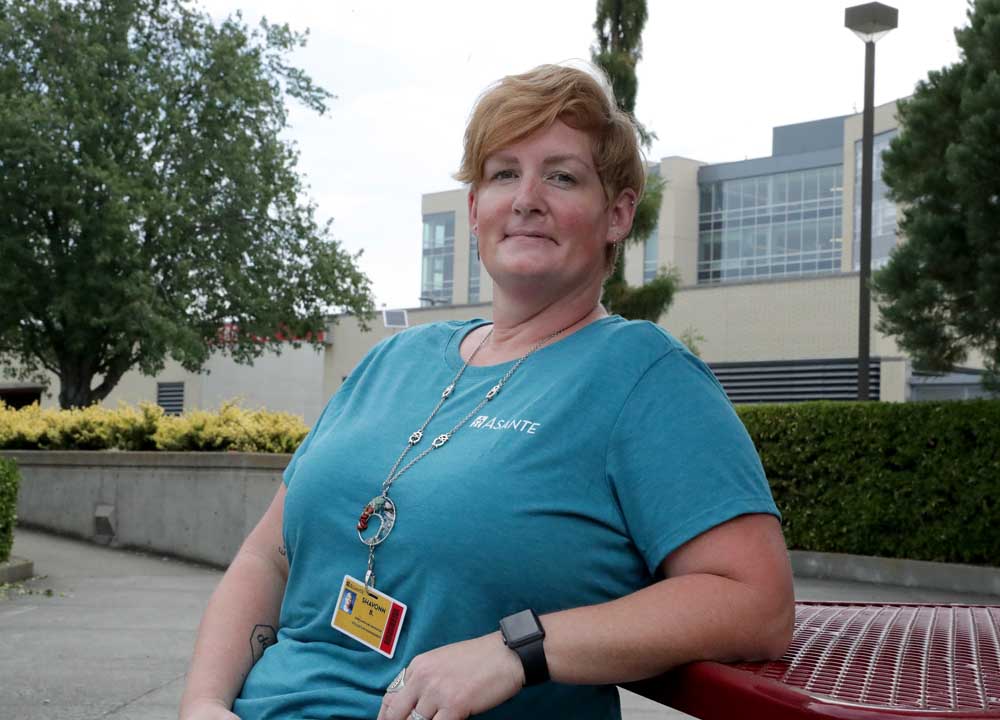Filling care gap, Asante hires navigator for patients with opioid use disorder
Published 1:45 pm Wednesday, August 23, 2023

- Shavonn Barrett has been hired as the first substance use disorder navigator at Asante Rogue Regional Medical Center in Medford.
Eight years ago, Shavonn Barrett took a housekeeping job at Asante Rogue Regional Medical Center in Medford. She cleaned rooms after patients vacated them.
But her goal was to help people caught in a battle — addiction — she had won two years earlier.
Barrett worked her way up to housekeeping supervisor, gained leadership skills, earned a degree in criminal justice and became certified as a recovery mentor.
In July, Asante hired her as its first substance use disorder navigator — a relatively new position in health care. This person works to make sure that patients who begin treatment for addiction at a hospital don’t fall back into addiction once they’re discharged.
Rogue Regional has been treating opioid use disorder for a few years, but patients often risked losing their progress before resuming their treatment elsewhere. Many would soon reappear at the hospital. They needed someone to help them stay the course.
“I’m someone who’s been there, lived it, and I’m proof that it’s possible to change your life,” Barrett said.
Patients don’t visit the hospital for rehab but for some other condition — such as an abscess or complicated childbirth — that may lead heath care workers to see, or suspect, that opioid use is involved. Perhaps a patient has track marks on their arms, or withdrawal shakes, or a documented history of abruptly leaving hospitals against medical advice.
The medical staff and social workers — Barrett’s department — piece together a clinical picture of what’s going on. If addiction is part of it, they try to build a rapport with the patient and persuade them to start treatment. If they’re reluctant, Barrett may nudge them.
Erin Brender, an Asante physician leading the treatment initiative there, said, “Oftentimes, you just say, ‘Look, I’m here to help you. I really want to help you, and I think I can.’”
Hospitalizations present a reachable moment in the lives of OUD patients. “You have a bit of a circle of influence at that time,” Brender said.
Physicians prescribe and nurses administer medication — methadone or buprenorphine — that suppresses cravings and eases withdrawal without mimicking opioids’ euphoria. They also use drugs that just target withdrawal symptoms.
“One person has told me that they’re ready, and they feel like they’ve been given a second chance by God. So that was pretty powerful.”
— Shavonn Barrett, Asante’s first substance use disorder navigator
Barrett then lets patients know what community resources — treatment and detox centers, mental health counseling and housing options, peer and church-based support — can help them stabilize and stay sober. Once patients leave, she follows up with them, sees how they’re doing, makes sure they made it to the next station on their journey.
As of Monday, Barrett had seen about two dozen patients, she said.
“One person has told me that they’re ready, and they feel like they’ve been given a second chance by God,” she recalled. “So that was pretty powerful.”
Her position is partially funded by Jackson County with opioid settlement funds — money coming in installments to states, counties, cities and tribes from pharmaceutical companies that fed the nationwide opioid addiction crisis.
As fentanyl took over the local illicit drug supply and overdoses exploded in Southern Oregon, medical staff grew frustrated. Many found themselves treating conditions obviously caused or worsened by opioid use but not the use itself, Brender said.
“It’s like any other medical condition: The more it goes on, the worse it gets,” she said. “And so we’re beholden to treat the underlying cause.”
In 2022, Rogue Regional joined more than 20 hospitals countrywide deemed “high-intensity sites” in a study, led by Oregon Health and Science University and the National Institute on Drug Abuse’s Clinical Trials Network, of hospital-based opioid treatment.
Providence Medford Medical Center — which is looking for its navigator — is part of the study.
Specialists at OHSU guided Asante as the program got started — they helped put protocols together and taught staff how to recognize signs of opioid use, initiate treatment and establish a referral pathway. Dr. Kerri Hecox, medical director at Oasis Center of the Rogue Valley, helped shape the program, which pulls together several Asante departments, from the medical staff and pharmacy, to social work, informatics and discharge planning. Rogue Regional also brings in recovery peers who help patients through the program and share their own experiences with them.
Although Asante’s focus is at Rogue Regional, Ashland Community Hospital and Three Rivers Medical Center in Grants Pass also treat opioid use disorder.
Brender said the hospitals treated 89 patients in January, 74 in February, 113 in March, 38 in April, 107 in May, 86 in June and 85 in July.
One challenge for Asante has been navigating the complex regulations of addiction medication.
Another, for Brender, has been getting her colleagues on board.
Asante essentially asked its hospital staff to face the opioid and fentanyl crisis just as another — the coronavirus pandemic — began to recede. Already understaffed, overwhelmed and burned out, medical workers now had to learn a new way to approach certain patients.
“When I went to medical school and I did my training, we weren’t taught how to treat this,” Brender said.
Even in the health care world, bias against the addicted population persists.
Karissa Camarillo gave birth at Rogue Regional in December 2021 at 35 weeks pregnant. An opioid user at the time, Camarillo recalls feeling judged by the labor and delivery nurses.
“They weren’t really supportive, and they looked down on me,” she said. “Like, terribly.”
Before the hospital joined the OHSU study and put protocols in place that allowed staff to take over OUD treatment, Hecox treated Asante patients, including Camarillo.
Hecox said Camarillo’s experience is not uncommon.
“It’s still going on, and people just feeling not heard, feeling like they’re treated like dirt — that, like, ‘Oh, it’s another addict’ kind of thing — and particularly in the OB (obstetrics) population,” Hecox said.
She added, “It has gotten much, much better over the last few years.”
Camarillo, who is now a medical assistant at Oasis, knows what would have happened had she not started opioid treatment at Rogue Regional.
“I would have left the hospital and continued getting loaded,” she said. “I can honestly say that I would have left my baby, and I would have continued being a fentanyl user.”
A 2021 article in The New England Journal of Medicine said: “Prescribing buprenorphine is one of the most effective ways to save a life. In one study” — published in Annals of Internal Medicine in 2018 — “buprenorphine treatment was associated with a 37% reduction in all-cause mortality during the year after a nonfatal overdose. This reduction is larger than the reduction in mortality associated with any blood-pressure medication, diabetic agent or statin. It is larger than the reduction associated with aspirin after an ST-segment elevation myocardial infarction.”
Brender points out this success rate to her fellow physicians.
“Addiction — they get frustrated with it because they see it as being hard to treat, but you just have to keep trying,” she said. “And it does work, you know? It’s highly effective.”






